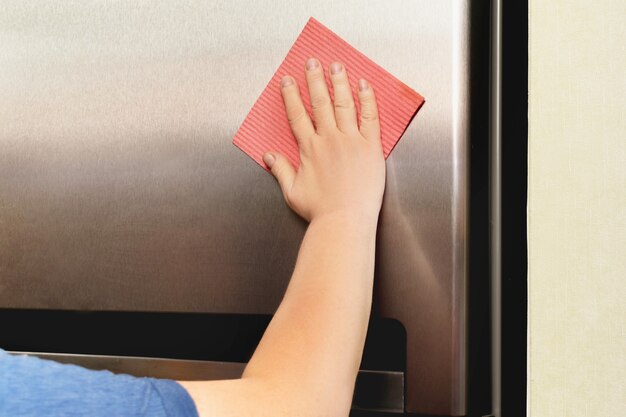Mastering Refrigerator Hygiene: Your Guide to Tackling Mold
Is there anything more off-putting than opening your refrigerator to find mold lurking in hidden corners or—worse—on your food? Tackling mold in a refrigerator might seem daunting, but with the right approach, it's a feasible task that can prevent future contamination. In this guide, we will explore practical steps for removing mold, delve into effective cleaning techniques, and look at preventative strategies to keep your refrigerator a mold-free zone.
Mold: What Is It and Why Does It Appear in Refrigerators?
Mold is a type of fungus that thrives in damp, warm, and poorly ventilated conditions. Although refrigerators are generally cold, certain factors like trapped moisture and organic material from spoiled food make them a surprisingly suitable environment for mold growth. Mold in the fridge can lead to unpleasant smells and pose potential health risks when ingested. This guide will help you not only to remove mold but also to understand its causes, so you can prevent future occurrences.
Identifying the Culprits Behind Mold Growth
- Humidity and Moisture: Condensation can build up inside the fridge due to improper sealing or leftover wet items.
- Temperature Fluctuations: Frequent opening of the refrigerator door or faulty temperature control can create conditions conducive to mold.
- Expired or Spoiled Food: Mold loves organic matter. A forgotten rotting vegetable or unsealed leftovers are ideal breeding grounds.
How to Get Mold Out of the Refrigerator: Step-by-Step Guide
Now, let's tackle the challenge head-on. Follow these steps to effectively remove mold from your refrigerator.
Initial Preparation
Before you start cleaning, gather the necessary tools and materials:
- Rubber gloves
- Protective mask
- Warm water
- Mild detergent or dish soap
- White vinegar or baking soda
- Old toothbrush or scrubbing pad
- Soft cloth or sponge
- Spray bottle
- Garbage bag
Step 1: Safety First
🔒 Protect Yourself: Wear rubber gloves and a mask to prevent exposure to mold spores, which can be irritating or harmful when inhaled.
Step 2: Clear the Fridge
- Remove all items: Take out all the contents, ensuring you dispose of moldy or expired items in a garbage bag.
- Take out removable parts: Shelves, crisper drawers, and other detachable components should be removed for a thorough cleaning.
Step 3: Cleaning Surfaces
- Use Warm Soapy Water: Mix mild detergent with warm water. Wipe down all surfaces of the fridge, aiming to remove visible mold and grime.
- Tackle Tough Spots: Use an old toothbrush or a scrubbing pad to scour areas where mold is stubborn. Pay special attention to door seals.
Step 4: Disinfect
- White Vinegar Solution: Fill a spray bottle with white vinegar and spritz all interior surfaces. Vinegar is a natural disinfectant that kills many types of mold.
- Alternative Method: Mix baking soda with water for a gentle abrasive cleaner. This is perfect for scrubbing up remaining spores.
Step 5: Clean Removable Parts
- Wash Components: Clean all shelves and drawers with the warm soapy solution and rinse thoroughly.
- Dry Everything: Ensure that all removed parts and cleaned surfaces are dry before reassembling your fridge. Moisture can lead to new mold growth.
Step 6: Ventilation and Reassembly
- Air Out the Fridge: Leave the fridge door open for a while to air out a bit before the next use. This also helps dissipate any lingering smell from vinegar or detergent.
- Return Items: Place clean, dry shelves back into their slots and arrange the food items properly.
Keeping Your Fridge Mold-Free for the Long Haul
Cleaning up mold is only half the battle. Employ these strategies to keep your refrigerator mold-free in the future.
Routine Checks and Maintenance
- Regular Cleaning: Make it a habit to clean your fridge monthly. This stops mold from gaining a foothold.
- Check Seals and Gaskets: Ensure that refrigerator seals and door gaskets are airtight and replace them if they are worn.
- Maintain Consistent Temperature: Aim to maintain a temperature below 40°F (approximately 4°C) to deter mold growth.
Food Storage Tips
- Inspect Produce: Examine fruits and vegetables for any signs of spoilage before putting them in the fridge.
- Use Airtight Containers: Store leftovers in sealed containers to limit exposure to mold spores.
- Keep an Eye on Expiry Dates: Rotate older items to the front and use them sooner to avoid them spoiling unnoticed in the back.
Natural Deodorizers and Absorbents
- Baking Soda or Charcoal: Placing an open box of baking soda or activated charcoal in the fridge can help absorb odors that attract mold.
Quick Reference: Mold Removal Summary
✅ Essentials for Mold-Free Fridge:
- 🔍 Prevention First!: Regular clean-up and purging of expired items thwart mold spawns.
- 🧴 Clean Inside Out: Use mild soap and natural cleaners like vinegar for disinfection.
- 🔧 Maintain Parts: Make sure seals are tight, and the temperature remains consistent.
- 🌬️ Air Circulation: Allow airflow to prevent dampness and mold proliferation.
Keeping a refrigerator clean and mold-free is part of maintaining a healthy home. A bit of regular attention and adopting smart storage habits will keep your refrigerator sparkling clean, your food fresh, and your mind at ease.
